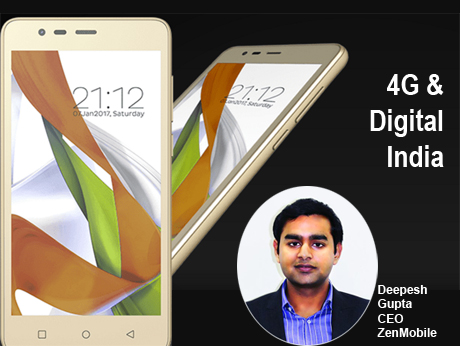
Deepesh Gupta, CEO Zen Mobile suggests why 4G is crucial to achieving the aims of Digital India
May 27 2017: India is one of the fastest growing internet markets in the world and is projected to have 730 million internet users by 2020 (Nasscom and Akamai Technologies). This growth is being led by the government’s Digital India initiative, collaboration among mobile internet ecosystem stakeholders and innovative content and service offerings from mobile-based services players. While smartphone continues to be on the rise in urban India, there is a huge potential of growth in rural India which will spearhead the next wave of digitization.
According to a recent report by Internet and Mobile Association of India (AMAI), India is expected to have 420 million mobile Internet users by June this year. Of the 420 million, about 250 million users are expected to come from urban India, while the remaining 170 million would be in rural parts of the country. These figures demote that there is tremendous scope of digital adoption in rural India.
Over the past few years, there has been a surge in the consumption of content and change in the buying pattern. Mobile led internet penetration has further boosted various sectors such as e-commerce, travel, hospitality, finance technology etc. Consumers living in tier II and tier III markets are reaping the benefits of digital initiative the most, as even the most affordable smartphone is offering the best VoLTE experience. This is also one of the primary reasons of feature phone users migrating to smartphones. A recent report by Counterpoint, LTE-capable smartphones contributed 96% of total smartphone shipments in Q1 2017. LTE is now a default feature for smartphones in India, and is playing a crucial role in Digital India initiative of the government as it can be used for high-bandwidth communication like video streaming as well as for not do demanding communication application.
With the government promoting cashless economy, the role of smartphone will not be limited to social media. For example - One of the positive impacts of demonetization has been the exploration of alternate methods of payment such as use of e-wallets, digital transaction apps such as BHIM, PAYTM etc. Life would not have been easier during these days had 4G penetration and smartphones played an equally important part. Smartphones is not a luxury anymore it has become a necessity.
Demonetization is just one aspect of it, many important initiatives of the government are been launched either on online platform or through mobile apps like MyGov app, eSign, E-education, E-health, etc. to bridge the connectivity gap between the rural and urban areas. This will provide transparency in the services provided by the government and will let the government reach out to each and every individual, thus establishing direct connect with the masses.
For example- banking is expensive, especially for consumers living in a town where there is limited number of banks. In a developing country like India, large portions of the population don't have access to the financial services that we take for granted (for example, direct deposit, credit cards, or savings accounts). Smartphones allow for digital transactions that are both cheaper and safer than paying with cash, or saving cash under your mattress at home. Mobile phone-based finance also makes credit available to the poor, so they can invest in building a home or starting a small business.
Though the National Telecom Policy (NTP) of 2012 recognizes the importance of smart/mobile phones in delivering essential services. 4G smartphones will play a crucial role in its true sense to the mass market to help millions of people with opportunities, livelihood and in accessing essential services.